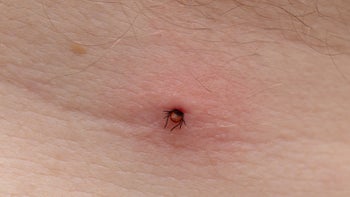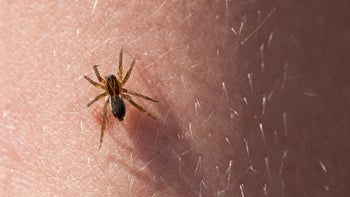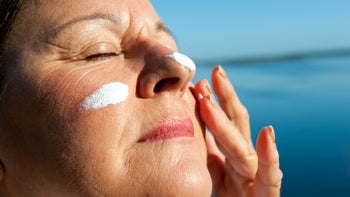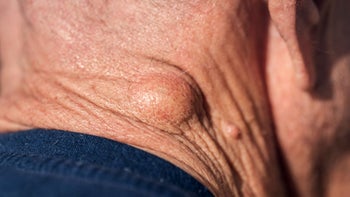
Can You Remove Moles at Home? Here’s the Deal With Mole Removal Kits and Other Home Remedies
Key takeaways:
Many over-the-counter products claim to remove moles, but there’s no evidence they work.
These products can cause serious side effects, like scarring, infection, and skin discoloration.
The FDA has not approved any at-home mole removal kits, and it warns against using any of them.
The best way to remove a mole — or any other skin growth — is to pay a visit to your dermatologist or healthcare provider.
Table of contents

Moles are common skin growths that affect most people at some point in their life. They’re usually nothing to worry about. But it’s not uncommon for people to feel bothered by them and consider getting them removed. Different commercial products claim to remove moles at home. But do they work? And are they safe?
Here’s what you need to know about moles and trying to remove them. It’s a classic case of “don’t try this at home.”
What is a mole?
Moles are a common, non-cancerous skin growth that many people have. (The medical term for them is nevus). They’re usually brown, but they can also be tan, pink, or skin colored. They are usually nothing to worry about. But some people can find them unsightly or irritating (like when they get caught in clothes).
Search and compare options
Not all moles are created equal, however. Some may contain atypical cells that make them more likely to develop into a skin cancer called melanoma. Most people can’t tell the difference between a regular mole and an atypical mole. And sometimes even a skin biopsy is needed for the correct diagnosis.
Is it safe to remove a mole by yourself?
The short answer is no. It’s never a good idea to remove a mole or any other skin growth you have.
One reason it’s not safe is that sometimes moles can be cancerous, or precancerous. You may think you’re removing a regular mole when you’re actually removing an atypical mole. What’s more, you may not get all of it out. And if that happens, you may actually be leaving cancerous or precancerous cells in your skin that could regrow.
There are other reasons it’s a bad idea to remove moles by yourself:
There could be bleeding that takes a while to stop.
Your skin could become infected.
There can be permanent scarring.
The removal could be incomplete (meaning it may come back).
Natural mole removal remedies you should NOT try
The FDA has not approved any over-the-counter mole removal treatments. But many different products are marketed as such. Often, these products contain high concentrations of chemicals like salicylic acid, calcium oxide, and other irritating ingredients.
Read more like this
Explore these related articles, suggested for readers like you.
These products can be sold as:
Creams
Ointments
Gels
Sticks
Liquids
There are also products that claim to be “natural” or “organic.” These contain ingredients such as grape seed extract, tea tree oil, vitamin E, and aloe vera extract. These may sound safe, but none of these products have been evaluated by the FDA for safety or effectiveness.
Do at-home mole removal kits work?
There are no at-home mole removal kits that have been proven to work.
In fact, the FDA has issued warning letters to the following companies for selling these products:
Amazon.com
Ariella Naturals
Justified Laboratories
That’s because there is no evidence that any of the ingredients in these products work to remove or reduce the appearance of moles. They just cause skin irritation.
Worse, these products can cause side effects and lasting damage to the surrounding skin, like burns, scarring, and discoloration. A recent study identified 38 people who have had serious skin injuries after using different at-home mole and skin tag removal kits.
If you’ve used any of these products and had a bad outcome, you can report it using the FDA’s MedWatch Safety Information and Adverse Event Reporting Program.
Signs your mole could be cancerous
Melanoma is the most serious form of skin cancer, and about 20% to 30% of cases start in a pre-existing mole. When looking at your moles, these ABCDE changes can help you spot one that could be cancerous:
A-symmetry: One half of the mole doesn’t look like the other half.
B-order: There is a bumpy or irregular border.
C-olor: There is more than one color present (like black, white, or pink).
D-iameter: The spot is larger than a pencil eraser.
E-volving: Any mole that is changing in size, shape, or color.
Melanoma is highly curable when you get it diagnosed early. That’s why it’s a good idea to keep an eye on your moles, including any on your back. If you do notice any changes, or you’re concerned about any of your spots, get them checked out by your dermatologist or provider as soon as you can.
What’s the best way to remove a mole?
The best — and safest — way to remove a mole is by going to a dermatologist or other healthcare provider. Here’s how that process will usually go:
Assess: First, they will assess the mole.
Remove: They’ll remove the mole, usually with a skin biopsy. That’s a minor surgical procedure done in the office. You’ll have some numbing medication injected into your skin with a small needle (local anesthetic). The mole is removed with a sharp blade. It may require a stitch or two if the mole is large.
Evaluate: The tissue then gets sent to a lab, where a pathologist evaluates it under a microscope to make sure it’s not concerning.
How much does mole removal cost?
If a mole removal is considered medically necessary, most insurance companies will cover the cost. If it’s just for cosmetic purposes, you’ll have to pay out of pocket. The cost will depend on a few different factors, like how big the mole is and where it’s located. Before getting it removed, talk to your provider about the cost so you know what to expect.
The bottom line
Removing moles — or any other skin growth — on your own is never a good idea. You could be trying to remove something atypical that needs more treatment. Or it could cause different side effects like infection, scarring, or discoloration. No over-the-counter product has been approved by the FDA to remove moles, despite what different products may claim. If you have a spot you’re worried about or want to remove, the best thing to do is to visit your dermatologist or healthcare provider.
Why trust our experts?


References
American Academy of Dermatology Association. (2023). Moles: Overview.
Food and Drug Administration. (2022). Products marketed for removing moles and other skin lesions can cause injuries, scarring.
Food and Drug Administration. (2023). MedWatch: The FDA Safety Information and Adverse Event Reporting Program.
Konkel, K., et al. (2023). Serious skin injuries following exposure to unapproved mole and skin tag removers. The Journal of Clinical and Aesthetic Dermatology.
Skin Cancer Foundation. (2023). DIY don’ts: Why at-home mole removal is a bad idea.
Skin Cancer Foundation. (2023). Melanoma warning signs.





























